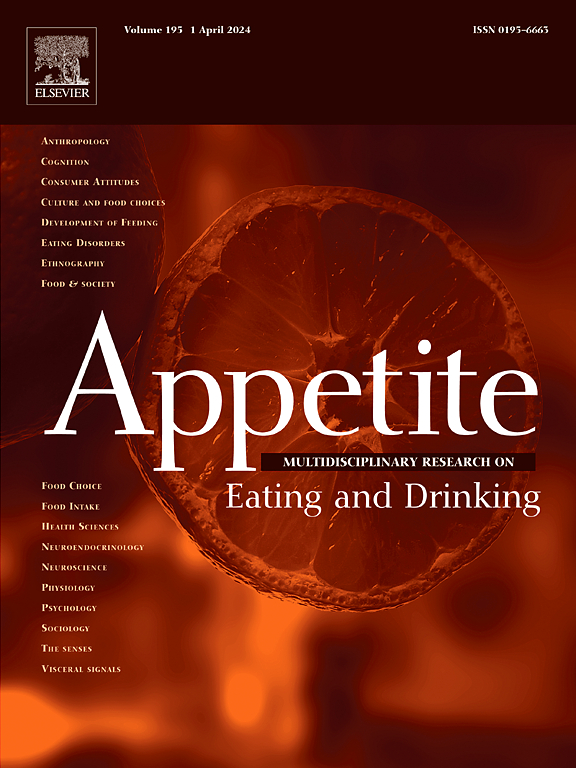Characterising the neural time-courses of food attribute representations
IF 3.8
2区 医学
Q1 BEHAVIORAL SCIENCES
引用次数: 0
Abstract
Dietary decisions involve the consideration of multiple, often conflicting, food attributes that precede the computation of an overall value for a food. The differences in the speed at which attributes are processed play an important role; however, it is unknown whether different attributes are processed over distinct time windows. We mapped the neural time-courses of 12 choice-relevant food attributes. Participants (N = 110) viewed food images while we recorded brain activity using electroencephalography (EEG). A separate group of participants (N = 421) rated the same images on nutritive properties (healthiness, calorie content, edibility, and level of transformation), hedonic properties (tastiness, willingness to eat, negative and positive valence, and arousal), and familiarity (previous exposure, recognisability, and typicality). Using representational similarity analysis, we quantified differences in patterns of multivariate EEG signals across foods and assessed whether the structure of these differences was correlated with differences in attribute ratings. We observed similar correlation time-courses for many attributes. There was an early window of correlations (∼200 ms from image onset), followed by sustained windows of correlation from ∼400 to 650 ms. Using principal component analysis, we identified a set of broader constructs that accounted for variance in ratings across multiple attributes, and were also correlated with the EEG data. Our results indicate that food attributes important for choice are represented rapidly and in parallel, over similar time windows. Furthermore, we reveal that broad dimensions underlying individual attributes are also represented in the neural activity with distinct time-courses, indicating a multilevel structure of food attribute representations.
表征食物属性表征的神经时间过程。
饮食决定涉及在计算食物的总体价值之前考虑多种经常相互冲突的食物属性。属性处理速度的差异起着重要作用;然而,是否在不同的时间窗口内处理不同的属性是未知的。我们绘制了12种与选择相关的食物属性的神经时间过程。参与者(N = 110)观看食物图像,同时我们使用脑电图(EEG)记录大脑活动。另一组参与者(N = 421)对相同的图片在营养特性(健康、卡路里含量、可食性和转化水平)、享乐特性(美味、吃的意愿、消极和积极的效价以及唤醒)和熟悉度(以前的接触、可识别性和典型性)方面进行了评分。采用代表性相似性分析,我们量化了不同食物的多变量脑电图信号模式的差异,并评估了这些差异的结构是否与属性评级的差异相关。我们观察到许多属性的相关时间过程相似。有一个早期的相关窗口期(从图像开始到200 ms),随后是持续的相关窗口期(400-650 ms)。使用主成分分析,我们确定了一组更广泛的结构,这些结构可以解释多个属性之间评级的差异,并且还与EEG数据相关。我们的研究结果表明,对于选择重要的食物属性是在相似的时间窗口内快速并行地表示的。此外,我们还发现,个体属性的广义维度在神经活动中也具有不同的时间过程,表明食物属性表征具有多层次结构。
本文章由计算机程序翻译,如有差异,请以英文原文为准。
求助全文
约1分钟内获得全文
求助全文
来源期刊

Appetite
医学-行为科学
CiteScore
9.10
自引率
11.10%
发文量
566
审稿时长
13.4 weeks
期刊介绍:
Appetite is an international research journal specializing in cultural, social, psychological, sensory and physiological influences on the selection and intake of foods and drinks. It covers normal and disordered eating and drinking and welcomes studies of both human and non-human animal behaviour toward food. Appetite publishes research reports, reviews and commentaries. Thematic special issues appear regularly. From time to time the journal carries abstracts from professional meetings. Submissions to Appetite are expected to be based primarily on observations directly related to the selection and intake of foods and drinks; papers that are primarily focused on topics such as nutrition or obesity will not be considered unless they specifically make a novel scientific contribution to the understanding of appetite in line with the journal's aims and scope.
 求助内容:
求助内容: 应助结果提醒方式:
应助结果提醒方式:


